Tsoulfanidis N. Measurement and detection of radiation
Подождите немного. Документ загружается.

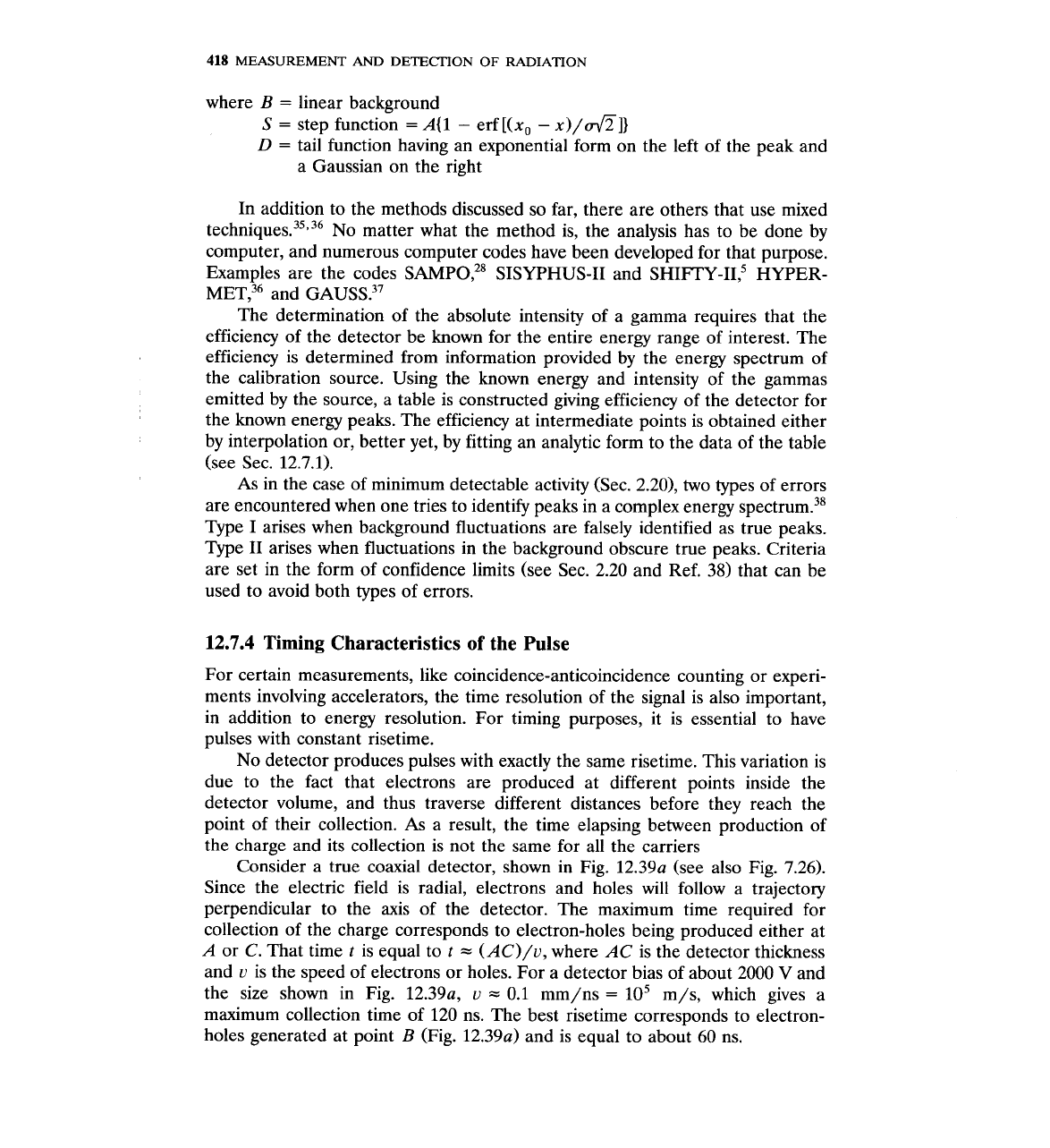
418
MEASUREMENT
AND
DETECTION
OF
RADIATION
where
B
=
linear background
S
=
step function
=
A(1
-
erf
[(x,
-
x)/&]}
D
=
tail function having an exponential form on the left of the peak and
a Gaussian on the right
In addition to the methods discussed so far, there are others that use mixed
technique^.^^,^^
No matter what the method is, the analysis has to be done by
computer, and numerous computer codes have been developed for that purpose.
Examples are the codes sAMPO?~ SISYPHUS-I1 and SHIITY-11: HYPER-
and GAUSS.37
The determination of the absolute intensity of a gamma requires that the
efficiency of the detector be known for the entire energy range of interest. The
efficiency is determined from information provided by the energy spectrum of
the calibration source. Using the known energy and intensity of the gammas
emitted by the source, a table is constructed giving efficiency of the detector for
the known energy peaks. The efficiency at intermediate points is obtained either
by interpolation or, better yet, by fitting an analytic form to the data of the table
(see Sec. 12.7.1).
As in the case of minimum detectable activity (Sec. 2.20), two types of errors
are encountered when one tries to identify peaks in a complex energy
spectrum.38
Type I arises when background fluctuations are falsely identified as true peaks.
Type I1 arises when fluctuations in the background obscure true peaks. Criteria
are set in the form of confidence limits (see Sec. 2.20 and Ref. 38) that can be
used to avoid both types of errors.
12.7.4 Timing Characteristics
of
the Pulse
For certain measurements, like coincidence-anticoincidence counting or experi-
ments involving accelerators, the time resolution of the signal is also important,
in addition to energy resolution. For timing purposes, it is essential to have
pulses with constant risetime.
No detector produces pulses with exactly the same risetime. This variation is
due to the fact that electrons are produced at different points inside the
detector volume, and thus traverse different distances before they reach the
point of their collection. As a result, the time elapsing between production of
the charge and its collection is not the same for all the carriers
Consider a true coaxial detector, shown in Fig. 12.39~ (see also Fig. 7.26).
Since the electric field is radial, electrons and holes will follow a trajectory
perpendicular to the axis of the detector. The maximum time required for
collection of the charge corresponds to electron-holes being produced either at
A or C. That time
t
is equal to
t
=
(AC)/u, where AC is the detector thickness
and
u
is the speed of electrons or holes. For a detector bias of about 2000
V
and
the size shown in Fig. 12.39a,
u
=
0.1 mm/ns
=
lo5
m/s, which gives a
maximum collection time of 120 ns. The best risetime corresponds to electron-
holes generated at point
B
(Fig. 12.39~) and is equal to about 60 ns.
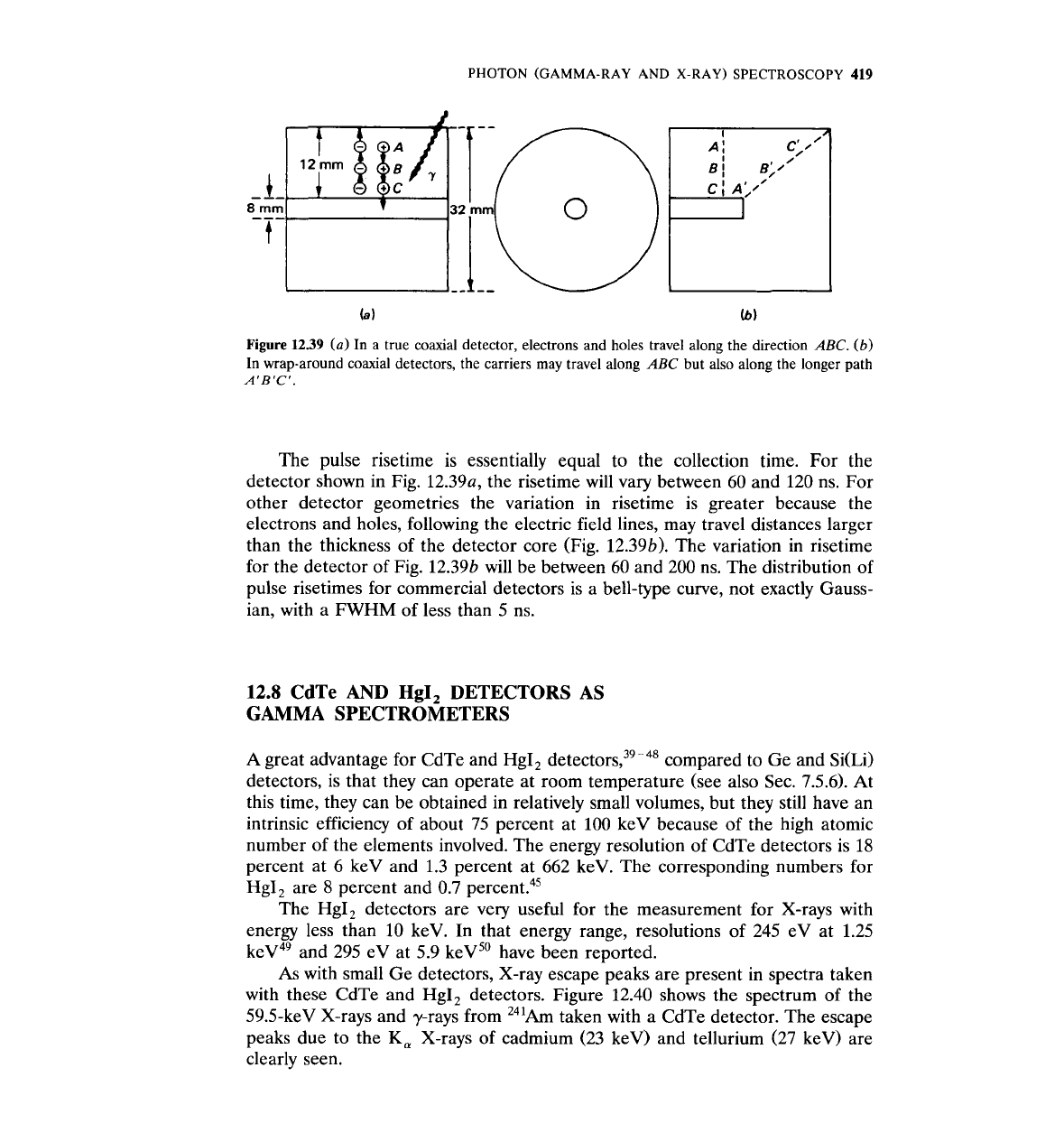
PHOTON
(GAMMA-RAY
AND
X-RAY)
SPECTROSCOPY
419
Figure
1239
(a)
In a true coaxial detector, electrons and holes travel along the direction ABC.
(b)
In wrap-around coaxial detectors, the carriers may travel along ABC but also along the longer path
A'B'C'.
The pulse risetime is essentially equal to the collection time. For the
detector shown in Fig. 12.39a, the risetime will vary between 60 and 120 ns. For
other detector geometries the variation in
risetime is greater because the
electrons and holes, following the electric field lines, may travel distances larger
than the thickness of the detector core (Fig. 12.396). The variation in
risetime
for the detector of Fig. 12.396 will be between 60 and 200 ns. The distribution of
pulse risetimes for commercial detectors is a bell-type curve, not exactly Gauss-
ian, with a FWHM of less than 5 ns.
12.8
CdTe AND
HgI,
DETECTORS AS
GAMMA
SPECTROMETERS
A great advantage for CdTe and HgI,
detector^,^^-^^
compared to Ge and Si(Li)
detectors, is that they can operate at room temperature (see also Sec. 7.5.6). At
this time, they can be obtained in relatively small volumes, but they still have an
intrinsic efficiency of about 75 percent at 100 keV because of the high atomic
number of the elements involved. The energy resolution of CdTe detectors is 18
percent at 6
keV and 1.3 percent at 662 keV. The corresponding numbers for
HgI, are
8
percent and 0.7 percent.45
The HgI, detectors are very useful for the measurement for X-rays with
energy less than 10
keV. In that energy range, resolutions of 245 eV at 1.25
ke~~~ and 295 eV at 5.9 kevso have been reported.
As with small Ge detectors, X-ray escape peaks are present in spectra taken
with these CdTe and HgI, detectors. Figure 12.40 shows the spectrum of the
59.5-keV X-rays and y-rays from 241~rn taken with a CdTe detector. The escape
peaks due to the
K,
X-rays of cadmium (23 keV) and tellurium (27 keV) are
clearly seen.
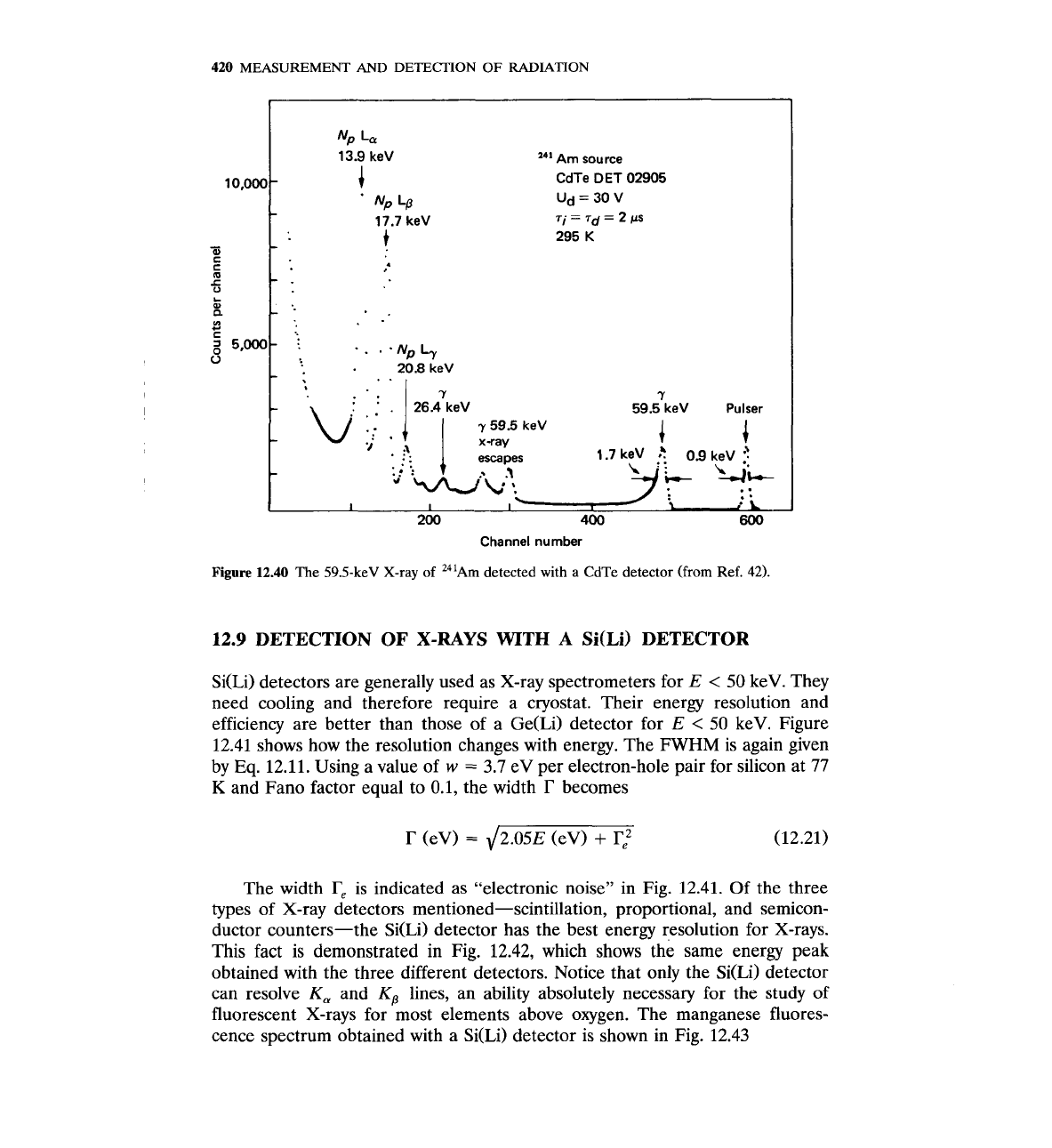
420
MEASUREMENT
AND
DETECTION
OF
RADIATION
I
Np
La
13.9
keV
14'
Am source
10.000
4
CdTe
DET
02905
'
NP
Ud
=
30
V
17.7
keV
7i=~d=2@
Pulser
i
Channel number
Figure
12.40
The 59.5-keV
X-ray
of
241~m
detected with
a
CdTe detector
(from
Ref.
42).
12.9
DETECTION OF
X-RAYS
WITH
A
Si(Li)
DETECTOR
Si(Li) detectors are generally used as X-ray spectrometers for
E
<
50
keV. They
need cooling and therefore require a cryostat. Their energy resolution and
efficiency are better than those of a Ge(Li) detector for
E
<
50
keV. Figure
12.41 shows how the resolution changes with energy. The FWHM is again given
by Eq. 12.11. Using a value of
w
=
3.7 eV per electron-hole pair for silicon at 77
K
and Fano factor equal to 0.1, the width
r
becomes
The width
re
is indicated as "electronic noise" in Fig. 12.41. Of the three
types of X-ray detectors mentioned-scintillation, proportional, and semicon-
ductor counters-the Si(Li) detector has the best energy resolution for X-rays.
This fact is demonstrated
in
Fig. 12.42, which shows the same energy peak
obtained with the three different detectors. Notice that only the Si(Li) detector
can resolve
K,
and
Kp
lines, an ability absolutely necessary for the study of
fluorescent X-rays for most elements above oxygen. The manganese fluores-
cence spectrum obtained with a Si(Li) detector is shown in Fig. 12.43
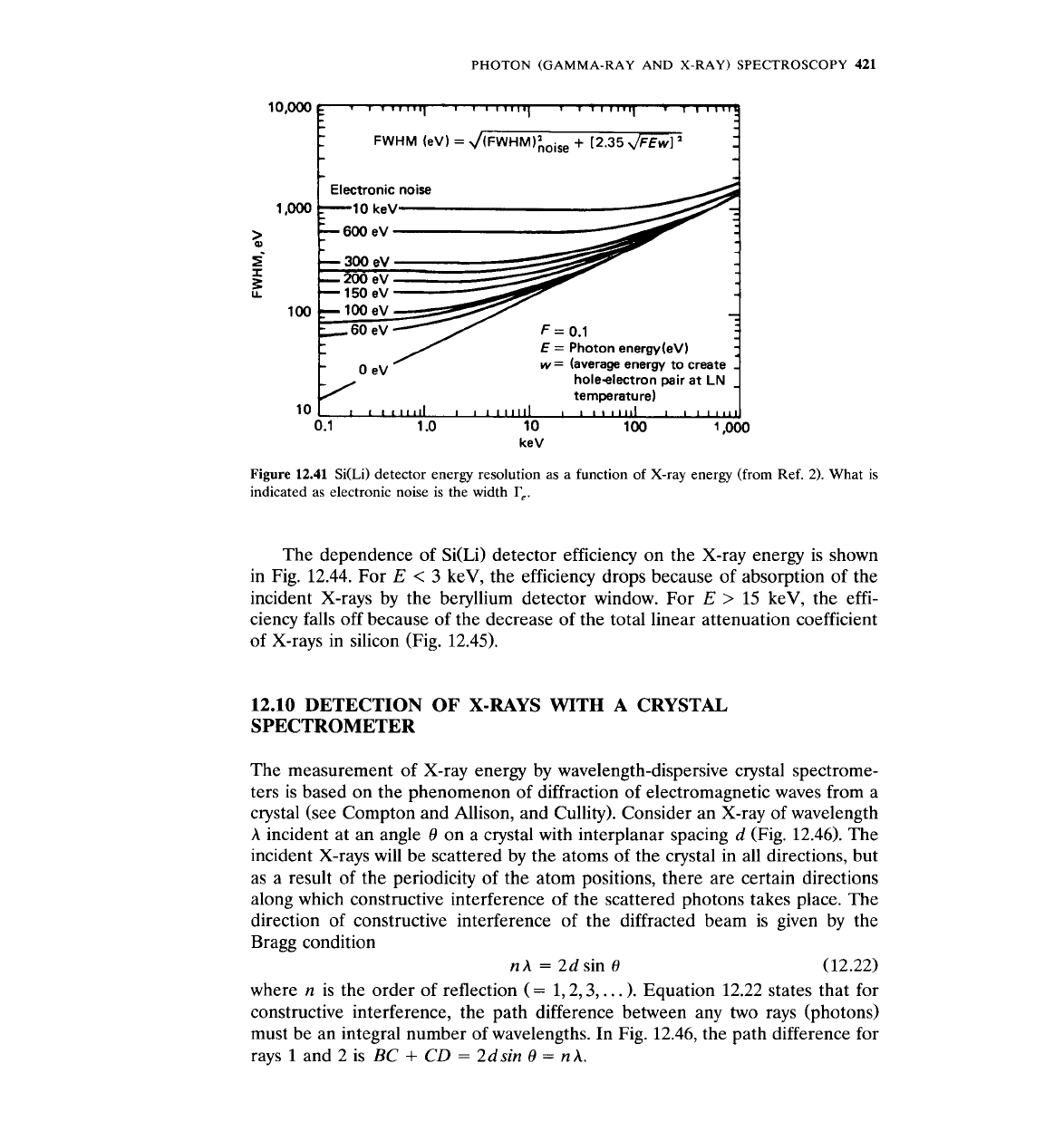
PHOTON
(GAMMA-RAY AND
X-RAY)
SPECTROSCOPY
421
L
-
FWHM (eV)
=
J(FwHM);,~,,
+
r2.35
JFEWI
-
-
- -
-
-
Electronic noise
1,000
-
-10
keV
2
r:
3
LL
E
=
Photon energy(eV1
0
eV
w
=
(average energy to create
-
holeelectron pair at
LN
-
temperature)
10
I
1
11
1111
I
11
111111
1
11111111
1
I1
Ill&
0.1 1
.o
10 100
~,OOo
keV
Figure
12.41
Si(Li) detector energy resolution as a function of X-ray energy (from Ref.
2).
What is
indicated as electronic noise is the width
re.
The dependence of Si(Li) detector efficiency on the X-ray energy is shown
in Fig. 12.44. For
E
<
3
keV, the efficiency drops because of absorption of the
incident X-rays by the beryllium detector window. For
E
>
15 keV, the effi-
ciency falls off because of the decrease of the total linear attenuation coefficient
of X-rays in silicon (Fig. 12.45).
12.10
DETECTION OF X-RAYS WITH
A
CRYSTAL
SPECTROMETER
The measurement of X-ray energy by wavelength-dispersive crystal spectrome-
ters is based on the phenomenon of diffraction of electromagnetic waves from a
crystal (see Compton and Allison, and Cullity). Consider an X-ray of wavelength
A
incident at an angle
8
on a crystal with interplanar spacing d (Fig. 12.46). The
incident X-rays will be scattered by the atoms of the crystal in all directions, but
as
a
result of the periodicity of the atom positions, there are certain directions
along which constructive interference of the scattered photons takes place. The
direction of constructive interference of the diffracted beam is given by the
Bragg condition
nA
=
2dsin
0
(12.22)
where n is the order of reflection
(
=
1,2,3,.
. .
).
Equation 12.22 states that for
constructive interference, the path difference between any two rays (photons)
must be an integral number of wavelengths. In Fig. 12.46, the path difference for
rays
1
and 2 is
BC
+
CD
=
2dsin
8
=
n
A.
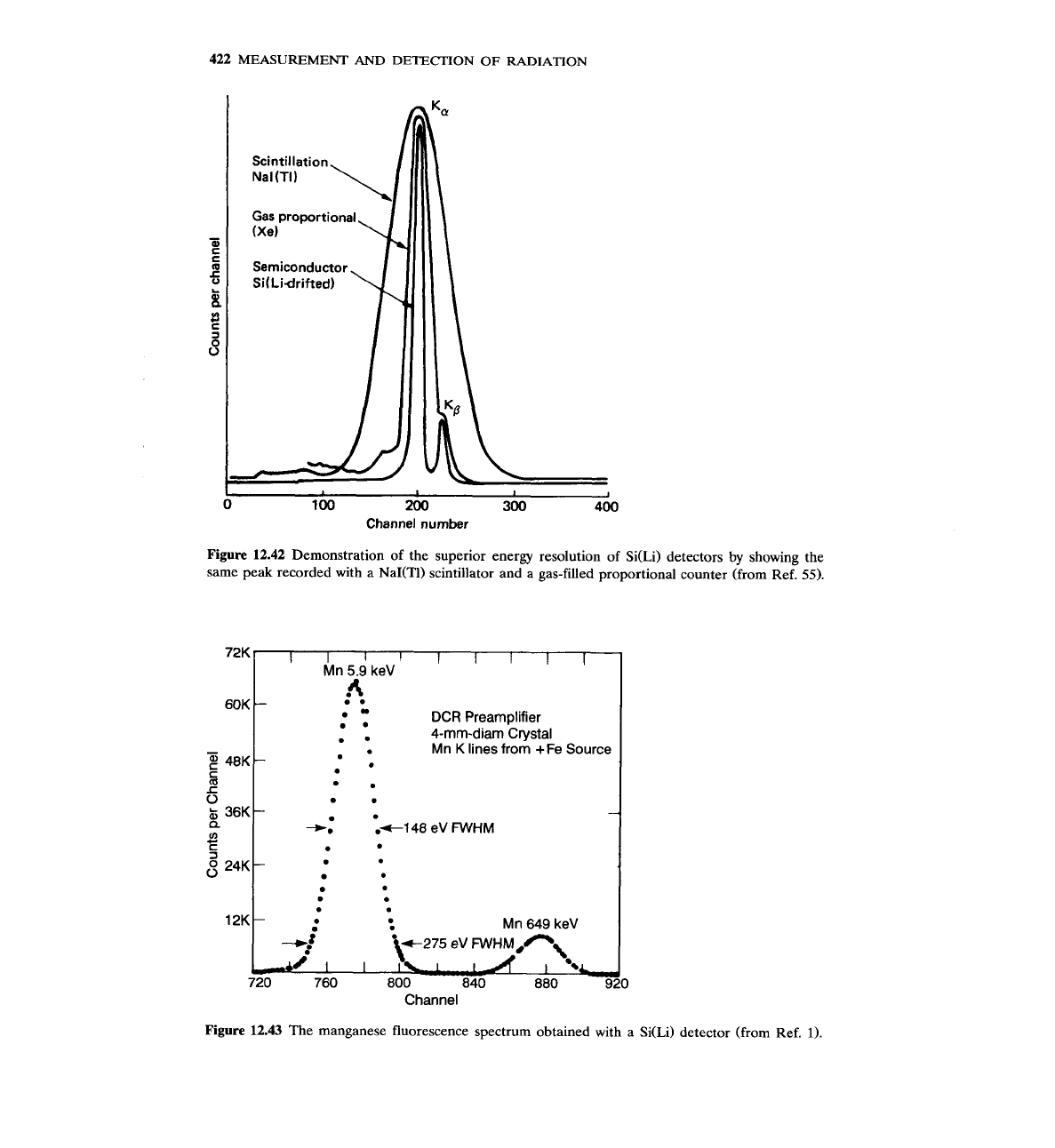
422
MEASUREMENT
AND
DETECTION OF RADIATION
Semiconductor
1
I
100
200
300 400
Channel number
Figure 12.42 Demonstration of the superior energy resolution of Si(Li) detectors by showing the
same peak recorded with a NaI(TI) scintillator and a gas-filled proportional counter (from Ref. 55).
6OK
1
A
.
.
. DCR Preamplifier
. 4-mm-diam Crystal
.
Mn
K
lines
from
+Fe
Source
.
-
.+I48 eV
FWHM
.
.
.
.
0
.
M n 649 keV
Channel
Figure 12.43 The manganese fluorescence spectrum obtained with a Si(Li) detector (from Ref.
1).
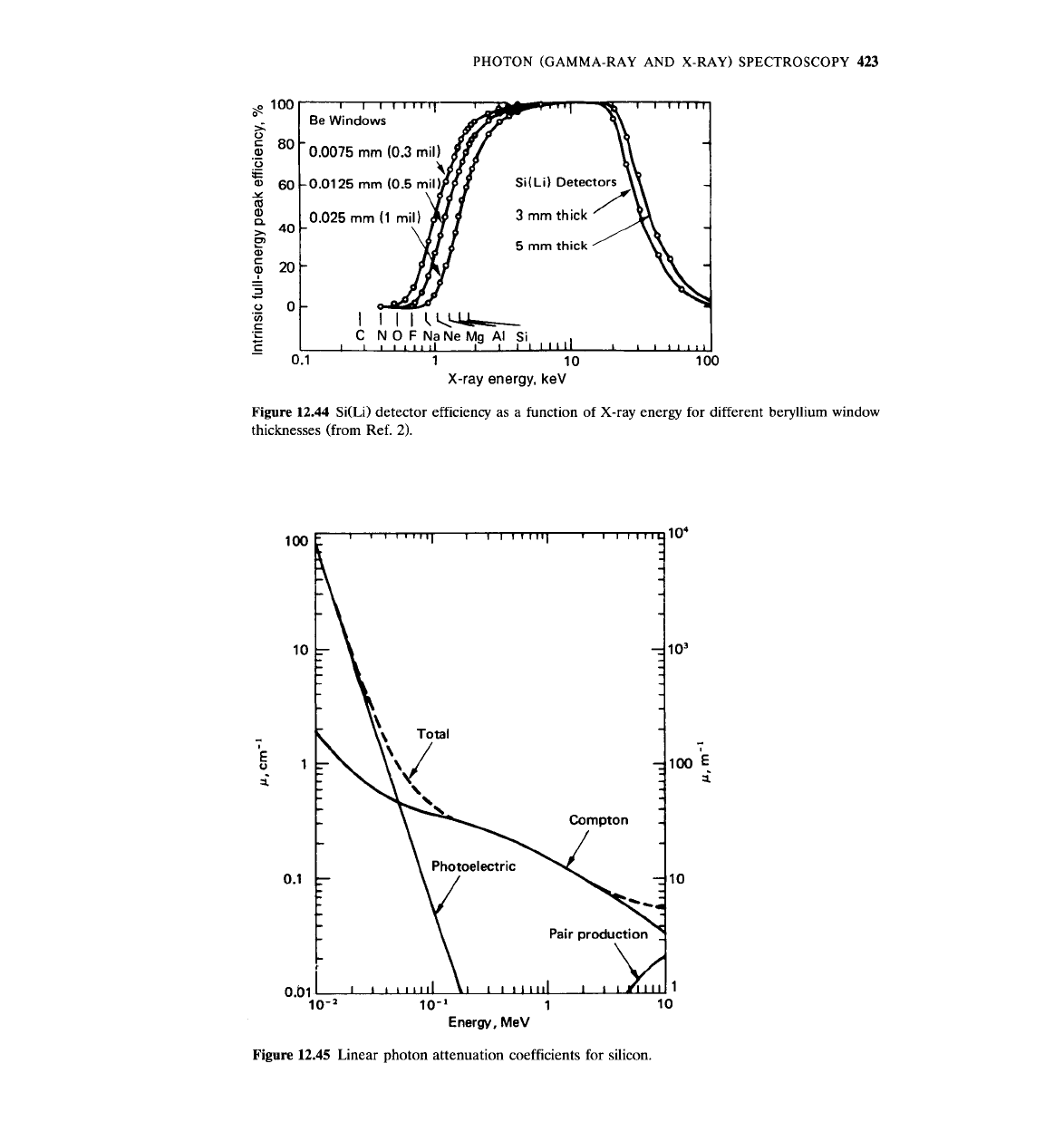
PHOTON (GAMMA-RAY AND X-RAY) SPECTROSCOPY 423
1
10
X-ray energy, keV
Figure
12.44
Si(Li) detector efficiency as a function of X-ray energy for different beryllium window
thicknesses (from Ref.
2).
Energy,
MeV
Figure
12.45 Linear photon attenuation coefficients for silicon.
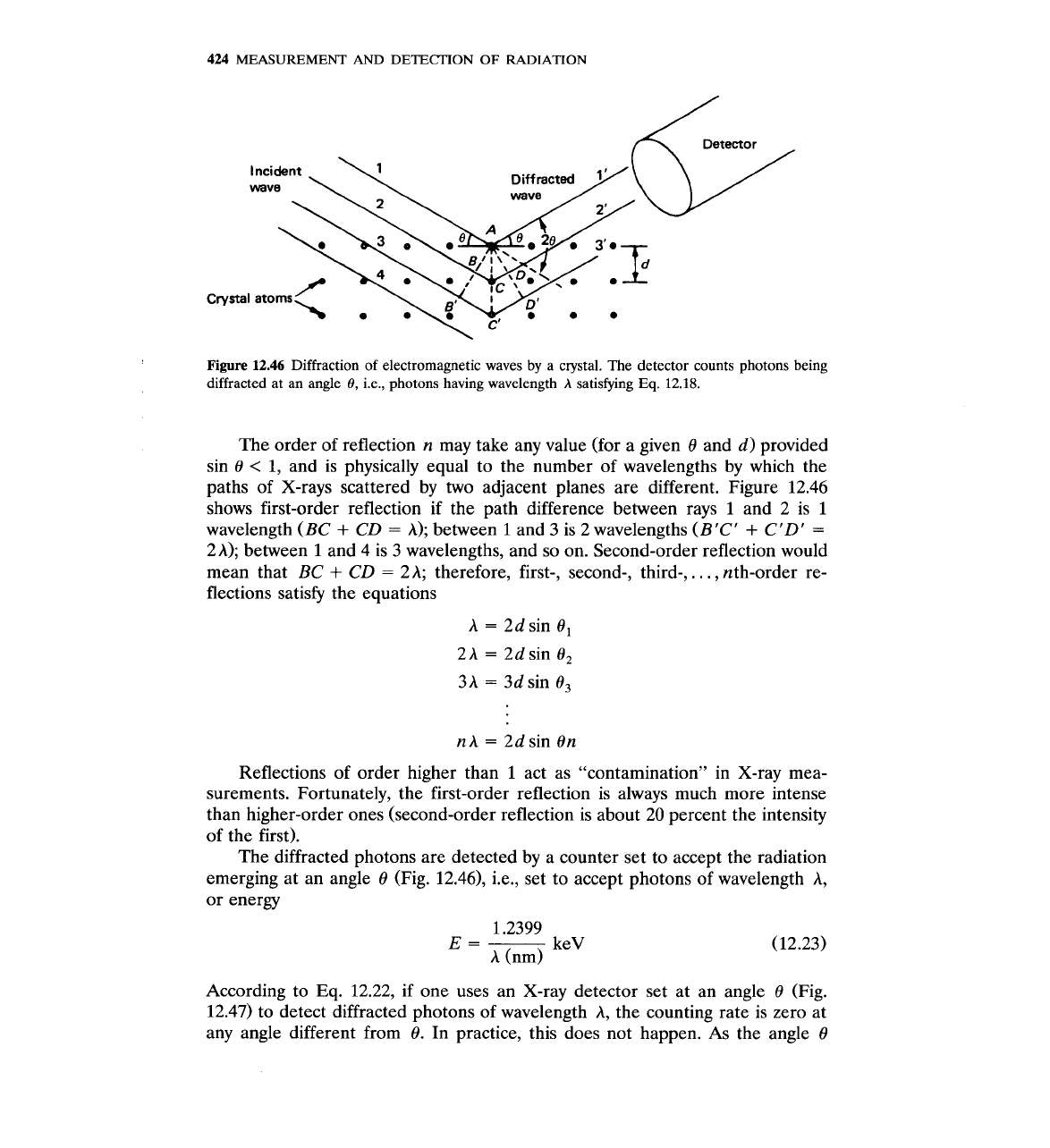
424
MEASUREMENT
AND
DETECTION
OF
RADIATION
Figure
12.46
Diffraction of electromagnetic waves
by
a crystal. The detector counts photons being
diffracted at an angle
0,
i.e., photons having wavelength
A
satisfying
Eq.
12.18.
The order of reflection n may take any value (for a given
8
and d) provided
sin 8
<
1,
and is physically equal to the number of wavelengths by which the
paths of X-rays scattered by two adjacent planes are different. Figure 12.46
shows first-order reflection if the path difference between rays
1
and 2 is
1
wavelength (BC
+
CD
=
A); between
1
and 3 is 2 wavelengths (B'C'
+
C'D'
=
2
A); between
1
and 4 is 3 wavelengths, and so on. Second-order reflection would
mean that
BC
+
CD
=
2
A; therefore, first-, second-, third-,
. . .
,
nth-order re-
flections satisfy the equations
A
=
2dsin
8,
2A
=
2d sin
8,
3A
=
3d sin
8,
nA
=
2d sin On
Reflections of order higher than
1
act as "contamination" in X-ray mea-
surements. Fortunately, the first-order reflection is always much more intense
than higher-order ones (second-order reflection is about 20 percent the intensity
of the first).
The diffracted photons are detected by a counter set to accept the radiation
emerging at an angle
8
(Fig. 12.46), i.e., set to accept photons of wavelength A,
or energy
According to
Eq.
12.22, if one uses an X-ray detector set at an angle
8
(Fig.
12.47) to detect diffracted photons of wavelength A, the counting rate is zero at
any angle different from 8. In practice, this does not happen. As the angle
8
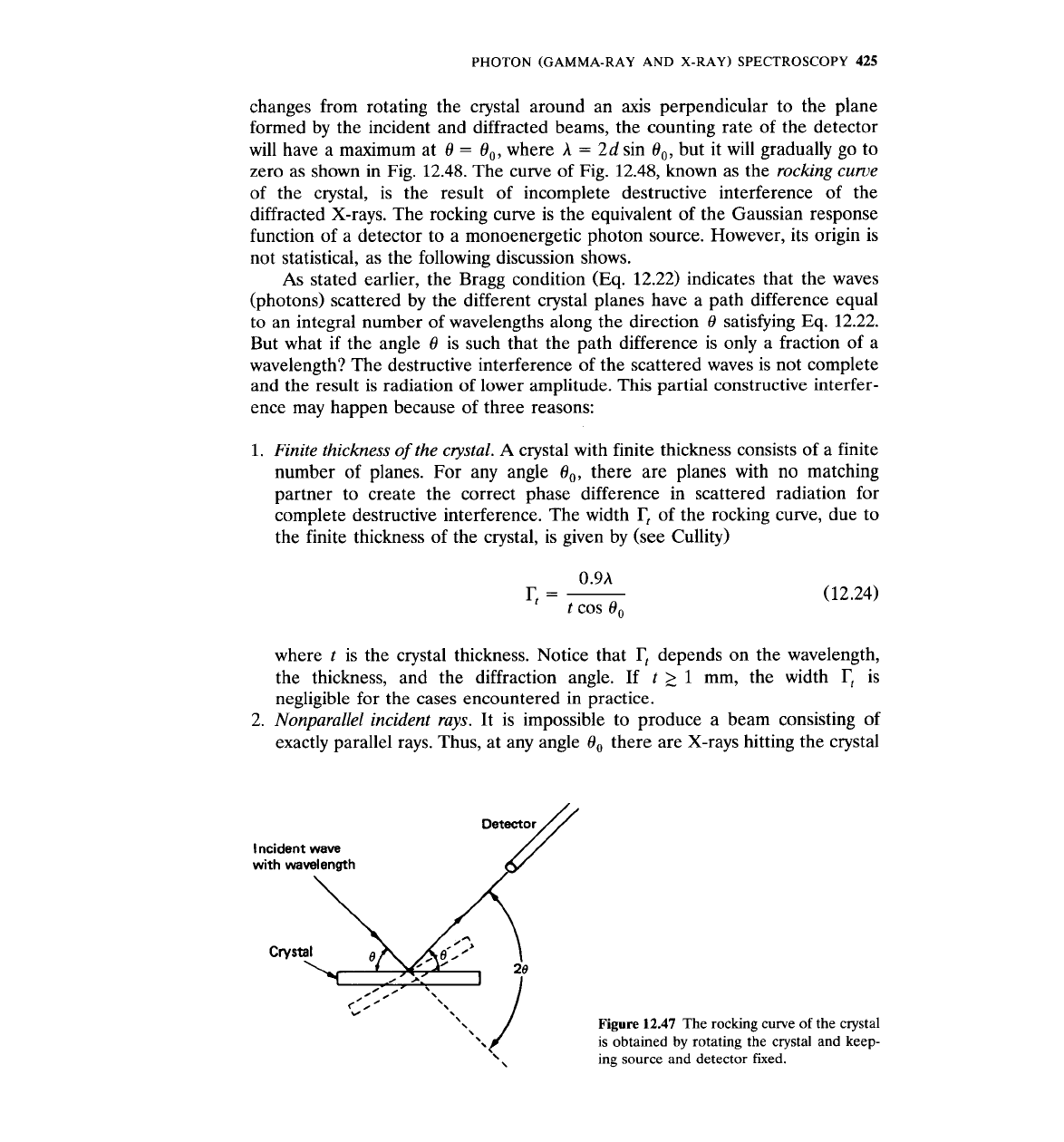
PHOTON
(GAMMA-RAY
AND
X-RAY) SPECTROSCOPY
425
changes from rotating the crystal around an axis perpendicular to the plane
formed by the incident and diffracted beams, the counting rate of the detector
will have a maximum at 8
=
00,
where
h
=
2d
sin O,, but it will gradually go to
zero as shown in Fig. 12.48. The curve of Fig. 12.48, known as the
rocking curve
of the crystal, is the result of incomplete destructive interference of the
diffracted X-rays. The rocking curve is the equivalent of the Gaussian response
function of a detector to a monoenergetic photon source. However, its origin is
not statistical, as the following discussion shows.
As stated earlier, the Bragg condition
(Eq.
12.22) indicates that the waves
(photons) scattered by the different crystal planes have a path difference equal
to an integral number of wavelengths along the direction
8
satisfying Eq. 12.22.
But what if the angle 8 is such that the path difference is only a fraction of a
wavelength? The destructive interference of the scattered waves is not complete
and the result is radiation of lower amplitude. This partial constructive interfer-
ence may happen because of three reasons:
1.
Finite thickness of the clystal.
A
crystal with finite thickness consists of a finite
number of planes. For any angle O,, there are planes with no matching
partner to create the correct phase difference in scattered radiation for
complete destructive interference. The width
T,
of the rocking curve, due to
the finite thickness of the crystal, is given by (see Cullity)
where
t
is the crystal thickness. Notice that
T,
depends on the wavelength,
the thickness, and the diffraction angle. If
t
>
1
mm, the width
T;
is
negligible for the cases encountered in practice.
2. Nonparallel incident rays.
It is impossible to produce a beam consisting of
exactly parallel rays. Thus, at any angle 8, there are X-rays hitting the crystal
l
ncident wave
with wavelength
Detector
/
Crystal
,
r.
0'
'\
'
.
L0
'.
Figure
12.47
The rocking curve of the c~ystal
.\.
/
is obtained by rotating the crystal
and
keep-
\
\
ing source and detector fixed.
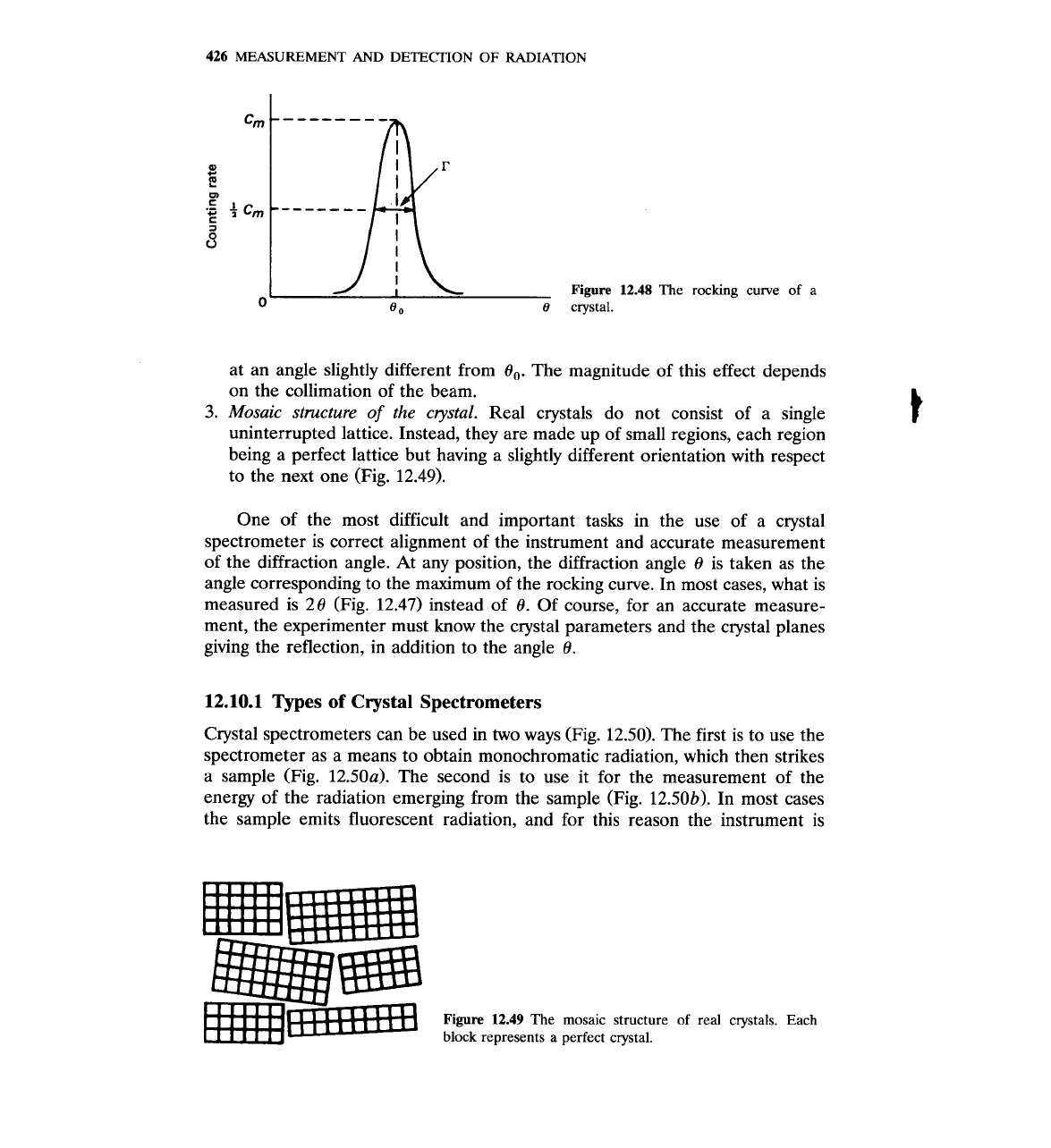
426
MEASUREMENT
AND
DETECTION OF RADIATION
Figure
crystal.
12.48
The
rocking
at an angle slightly different from
8,.
The magnitude of this effect depends
on the collimation of the beam.
3.
Mosaic structure of the cystal.
Real crystals do not consist of a single
uninterrupted lattice. Instead, they are made up of small regions, each region
t
being a perfect lattice but having a slightly different orientation with respect
to the next one (Fig.
12.49).
One of the most difficult and important tasks in the use of a crystal
spectrometer is correct alignment of the instrument and accurate measurement
of the diffraction angle. At any position, the diffraction angle
8
is taken as the
angle corresponding to the maximum of the rocking curve. In most cases, what is
measured is
28
(Fig.
12.47)
instead of
8.
Of course, for an accurate measure-
ment, the experimenter must know the crystal parameters and the crystal planes
giving the reflection, in addition to the angle
8.
12.10.1
Types of Crystal Spectrometers
Crystal spectrometers can be used in two ways (Fig.
12.50).
The first is to use the
spectrometer as a means to obtain monochromatic radiation, which then strikes
a sample (Fig.
12.50a).
The second is to use it for the measurement of the
energy of the radiation emerging from the sample (Fig.
12.50b).
In most cases
the sample emits fluorescent radiation, and for this reason the instrument is
Figure
12.49
The mosaic structure of real crystals. Each
block represents a perfect crystal.
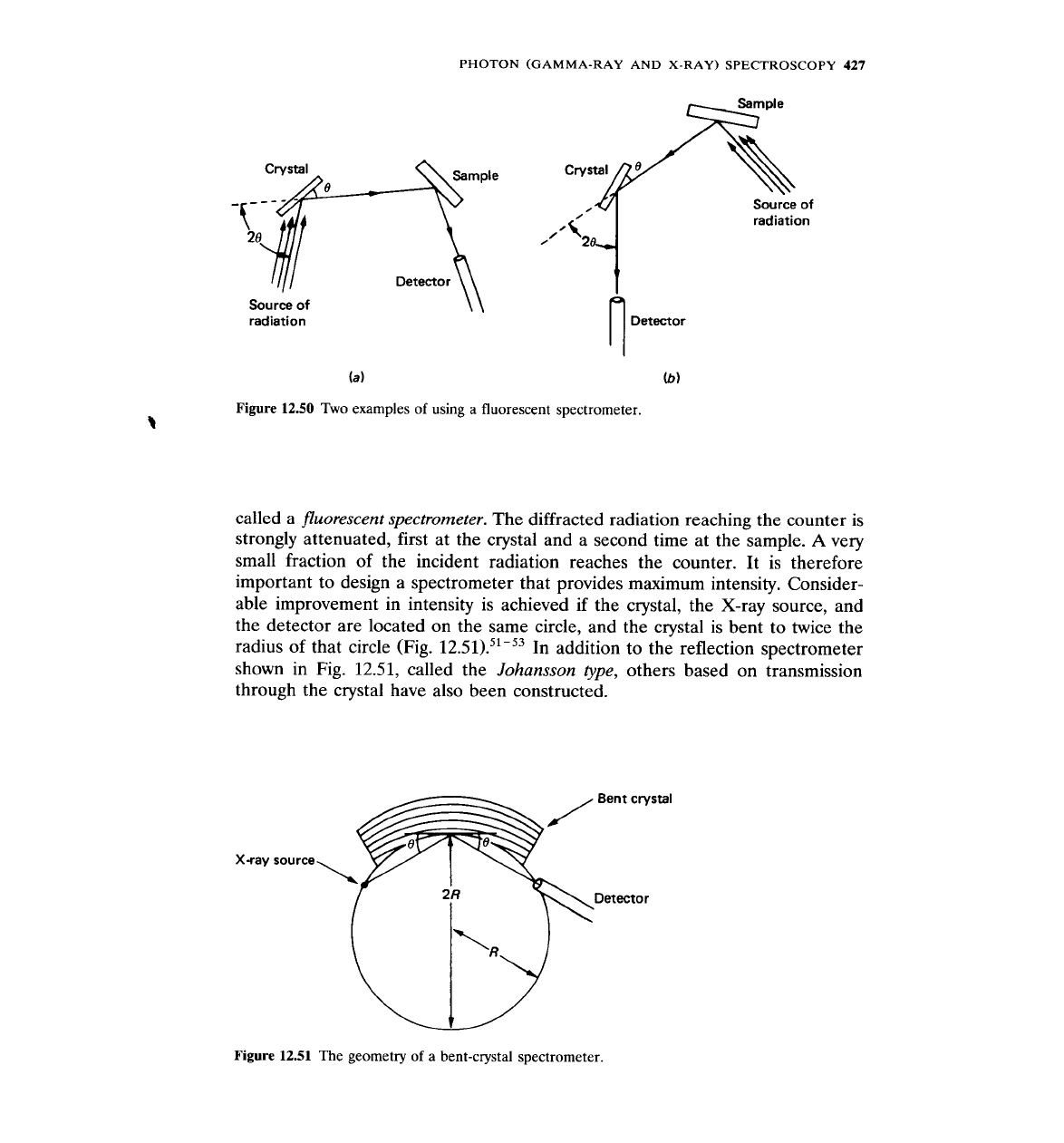
PHOTON
(GAMMA-RAY AND X-RAY)
SPECTROSCOPY
427
Crystal
Detector
Source of
radiation
\
\
Crystal
radiation
1
Detector
(a)
(6)
Figure
12.50
Two examples of using a fluorescent spectrometer.
called a
fluorescent spectrometer.
The diffracted radiation reaching the counter is
strongly attenuated, first at the crystal and a second time at the sample.
A
very
small fraction of the incident radiation reaches the counter. It is therefore
important to design a spectrometer that provides maximum intensity. Consider-
able improvement in intensity is achieved if the crystal, the X-ray source, and
the detector are located on the same circle, and the crystal is bent to twice the
radius of that circle (Fig.
12.51).~l-'~
In addition to the reflection spectrometer
shown in Fig.
12.51,
called the
Johansson
type,
others based on transmission
through the crystal have also been constructed.
X-ray source
Figure
12.51
The geometry
of
a bent-crystal spectrometer.
